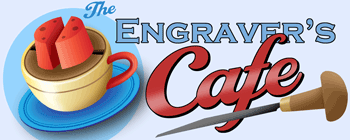thekoabenchgoldsmith
Member
- Joined
- Jul 20, 2007
- Messages
- 46
I have received the Ron Smith practice plates from GRS. Since I don't hardly ever cut steel I decided to cut borders around the plates to get a feel of the material. Just long straight cuts at first. Then a series of graduated circles...that sort of thing.
I pretty much set the 120 degree gravers up as rec ommended elsewhere: 45 degree face and very short 15 degree full-width parallel polished belly.
I found that the tool wanted to dive deeper and deeper into the metal. I lowered the angle to make the cut more shallow. But when the cuts became long enough for the handpieces (I am using a Magnum and a Monarch with the fine spring) to override the metal they bumped the edge of the plate. I lifted the handpiece up to clear the plate then the graver dove deeper into the material.
Should I increase the belly angle to allow a steeper cutting angle that produces a shallow cut? Or develop a cutting style that allows a shallow cut even with an angle steep enough to allow the handpiece to clear the plate?
Or is there another solution?
In the jewelry engraving I have done in the past the cutting was very deep, but it was never on a broad flat surface so handpiece clearance was never an issue.
Thank-you for any suggestions.
I will be getting my m'scope in a day or two and will begin to include images of the situations I post about after that.
Aloha,
Robert Booth
The Koa Bench Goldsmith
I pretty much set the 120 degree gravers up as rec ommended elsewhere: 45 degree face and very short 15 degree full-width parallel polished belly.
I found that the tool wanted to dive deeper and deeper into the metal. I lowered the angle to make the cut more shallow. But when the cuts became long enough for the handpieces (I am using a Magnum and a Monarch with the fine spring) to override the metal they bumped the edge of the plate. I lifted the handpiece up to clear the plate then the graver dove deeper into the material.
Should I increase the belly angle to allow a steeper cutting angle that produces a shallow cut? Or develop a cutting style that allows a shallow cut even with an angle steep enough to allow the handpiece to clear the plate?
Or is there another solution?
In the jewelry engraving I have done in the past the cutting was very deep, but it was never on a broad flat surface so handpiece clearance was never an issue.
Thank-you for any suggestions.
I will be getting my m'scope in a day or two and will begin to include images of the situations I post about after that.
Aloha,
Robert Booth
The Koa Bench Goldsmith






